Growing fresh produce like strawberries at home can be done year round with a hydroponic garden. Whether you plan to grow in a greenhouse, a garage or a spare room in your house, technology has made indoor growing easier and more efficient than traditional soil gardening.
Growing strawberries hydroponically, or without soil, requires a hydroponic planter (purchased or homemade), appropriate lighting and heat conditions, a growing medium, and liquid nutrients.
It’s not difficult to grow strawberries using a hydroponic growing method, but there are other important factors to create the right environment for your strawberries to thrive.
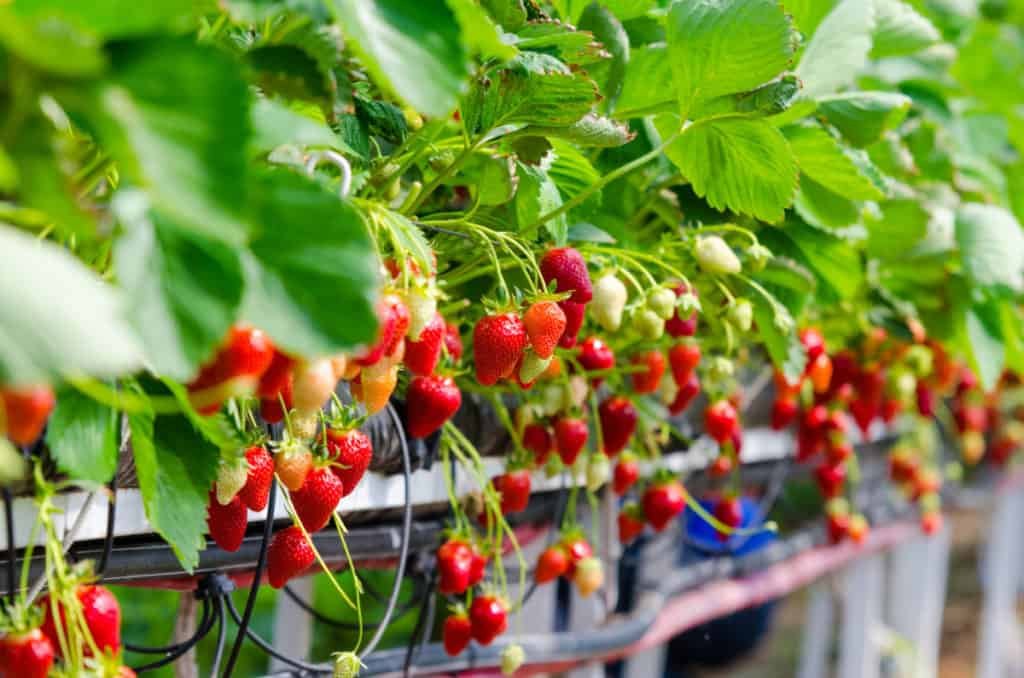
How to Grow Hydroponic Strawberries
Strawberries grow exceptionally well in a hydroponic system. And with just a little bit of equipment and work, you can start your own hydroponic strawberry patch!
Hydroponic systems are more efficient (in terms of space, growth time, and yield) and cleaner than traditional soil-based gardening. Unlike a conventional garden, a hydroponic garden does not require bending over or weeding either.
The nutrients that your plants need are delivered directly through a water line to the root systems of all your plants. Because the plants don’t have to “search” for the nutrients like they do when growing in soil, they have huge yields and grow more quickly!
Choose a Hydroponic Planter
If you’re interested in starting a hydroponic strawberry garden, you’ll need to start by purchasing or making your own hydroponic planter. Note that there are several varieties of hydroponic systems:
- Low Pressure Aeroponic (LPA) systems
- Ebb and Flow systems
- Deep water culture (DWC) systems
- Hydroponic drip systems
My go-to method for growing strawberries is using a Tower Garden vertical aeroponic system. The ready-to-grow automated garden produces the most picture perfect and delicious strawberries I’ve ever eaten.
It’s a closed loop system that reduces water usage by over 90% and can grow 20+ plants in a 3′ x 3′ space. I have a perpetual garden of strawberries, tomatoes, greens, cucumbers and peppers that I pick from any time of day. Check out What is a Tower Garden and How Does it Work? for more details.
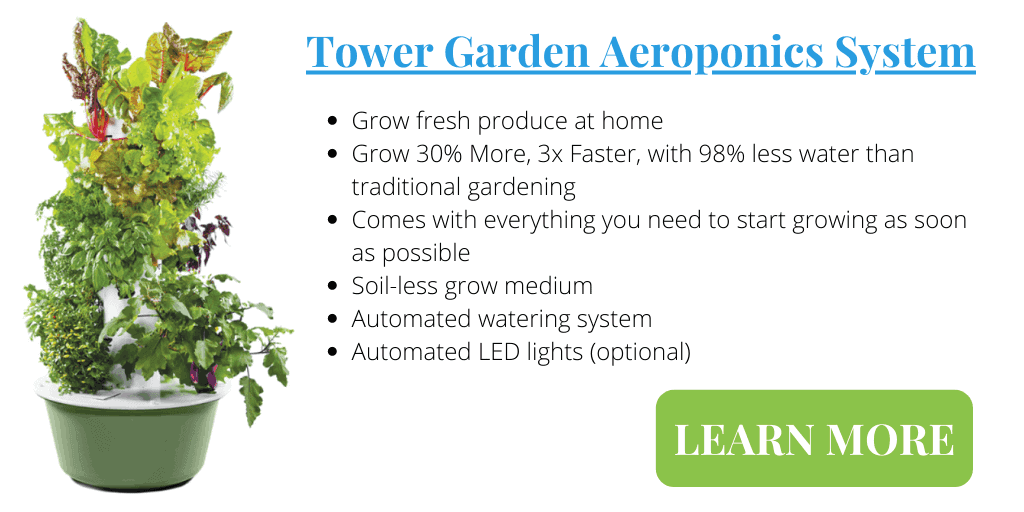
For strawberries, the safest and easiest bet is to grow with a low pressure aeroponics system. In this system, your strawberry plants get potted individually and the nutrient solution is supplied to their roots at regular intervals throughout the day. This is preferred over keeping them constantly submerged in water and nutrients.
While the other systems can also work for strawberry planting, an Aeroponics system is widely considered the most effective to avoid over-watering strawberries.
If you are looking for a cheaper option, there are also many ways to make your own hydroponic system, out of relatively inexpensive supplies.
Choose a Growing Medium
Once you have your hydroponic planter and watering system purchased or built, the next step is to pick a growing medium for your plants.
Instead of soil, a hydroponic system has another growing medium to hold your plants in place as the water and nutrients flow through the root systems. There are a few different options for mediums, including rock wool, clay pellets, and perlite. There are pros and cons to each of these choices.
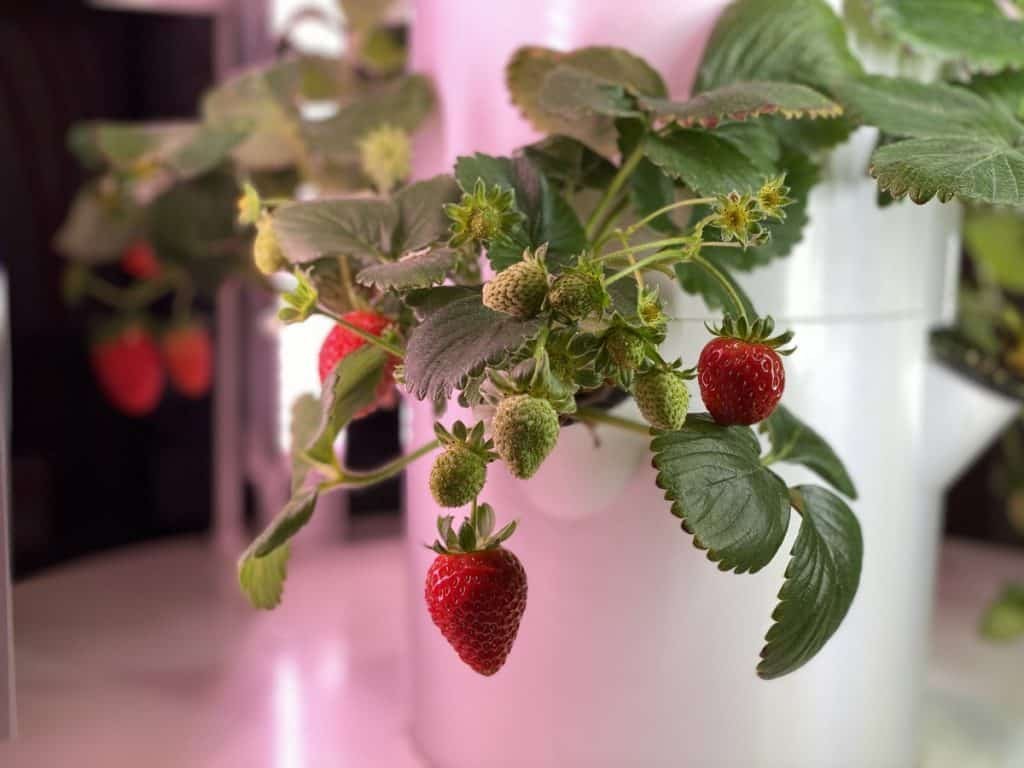
Rock Wool
A porous and non-degradable material that is made from limestone and granite heated to high temperatures, rock wool is one of the most common growing mediums for hydroponic systems.
After being heated, rock wool is stretched into small threads like “wool” and then formed into blocks that can be inserted into your hydroponic system. Because rock wool absorbs water very readily, it works great with an aeroponic or ebb and flow system.
Rockwool is extremely good at bringing the nutrients in your system to the roots of your plants but. Though it won’t fall apart in your system, it’s a one time use product.
Perlite
An extremely absorbent material made of minerals heated and processed, perlite is a common growing medium that can be used alone or combined with other growing media.
Depending on your hydroponic system, perlite might be a bad choice to use by itself because it floats, and thus can become easily displaced if not weighed down by another material.
One advantage of perlite is that it is readily available at most garden stores and does not cost much. It also more gradually disperses moisture and nutrients to your plants’ roots than rock wool does, helping to prevent over-watering or root rot.
However, the fact that it floats means that particles of it can be easily dispersed throughout your system, which will mean more frequent cleaning and replenishing of your growing medium.
Clay Pellets
Also often called “grow rocks,” these small, round clay pellets are very sturdy and supportive of plants’ roots. Their highly absorbent nature allows them to absorb lots of water quickly and keep excess moisture away from roots, preventing excessive watering. They are also reusable if they are cleaned between cycles.
However, over time they will break down if not replaced and can clog pipes in your hydroponic system. They are also a little harder to find in gardening stores than perlite, but can easily be ordered online.
There is no one growing medium that works better than all the others at everything. Each will help you produce a healthy hydroponic strawberry garden, so you’ll just need to weigh the pros and cons of each and determine which is best for you and your growing schedule, etc.
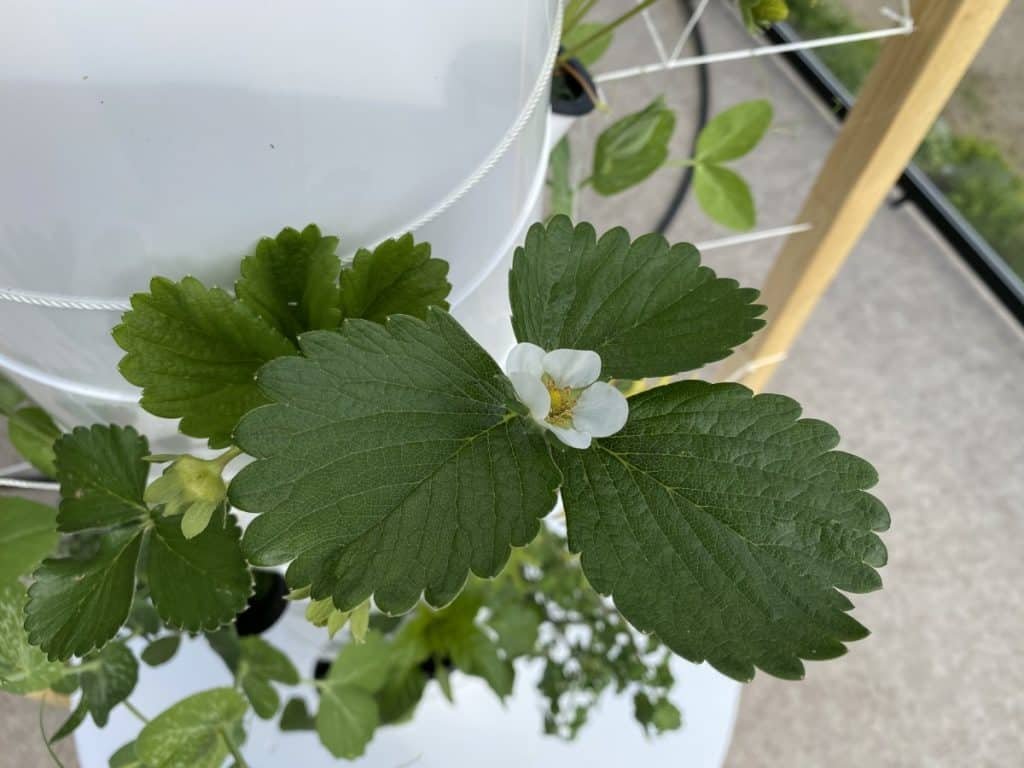
Plant Your Strawberries
Once you have your planter set up and your growing medium selected, it’s time to plant your strawberries!
Preparing Your Plants
It’s always best to start growing your strawberries from cuttings rooted in water or a cloning machine. For more details on cloning you can read my post on What is Aeroponic Cloning?
Another good solution is purchasing young strawberry plants at a nursery or transplanting them from an existing garden. Take your young strawberry plants, remove them from the soil, and rinse as much soil as possible from the roots. It’s easiest to soak the roots first before holding them under the tap.
Placing Your Plants in Pots
Whatever type of hydroponic system you’ve selected, it should have small pots in it to hold your strawberry plants. To plant, you’ll need to first fill the pots about halfway with your growing medium.
If using Rockwool cubes, make a cut down the side of the cube and wrap the Rockwool cube around the plant base with the roots extending out the bottom. Tie it back together using some string or wrap it with an elastic.
Insert your rinsed plants into each pot individually, and then fill the pot to the top with growing medium, securing the plant in place. Make sure the root system of your plant goes down far enough in the pot that it will be exposed to the water.
As soon as you have planted your strawberries, it’s a good idea to give each pot a good watering from “above” to help the plants and the growing medium settle in.
Ideal Growing Environment for Hydroponic Strawberries
Strawberries grow best in a fairly light environment, with a warm temperature around 65-80 degrees Fahrenheit. Keep this in mind as you plan the area you will have your hydroponic system in.
Lighting
As for light, strawberries are simple: 8-12 hours of light each day will keep them hearty and healthy. If your plants are not in a greenhouse or a space with adequate natural light, you’ll need supplemental lighting.
A simple set of full spectrum T8 LED grow lights will be sufficient. I use 4′ 42W lights on an automatic timer and my plants produce lots of flowers and berries.
The combination of red and blue wavelength available from a full spectrum grow light promotes root development, stem growth and higher yields.
- Full Spectrum: Barrina LED grow lights 4ft provide indoor plants with full-spectrum sunlight...
- Super Bright and High PPFD: Consuming only 252W with 1152 LEDS totally, replace 1400w general...
- Easy Installation: With included tape, clips and cable ties, you could install the lights by...
The lights should be positioned 8-12 inches away from the plant, either above for a horizontal garden or along side for vertical gardens. Use an automatic timer to keep the ON/OFF cycle simple and consistent for the plant.
pH Level
Because the water will be interacting directly with the roots of your plant, your water must have the right pH level. A pH level between 5.5 and 6.5 will be sufficient for your strawberries—anything outside of this range can be harmful to them or prevent their growth altogether. Use a pH meter to test the water pH levels in your reservoir after adding nutrients to it.
Nutrient Solutions For Your Strawberries
While some plants can grow in hydroponic systems with just water, strawberries will require a further nutrient supplement to keep them healthy and growing.
Liquid nutrients can be added directly to the water reservoir of your hydroponic system. Many companies make liquid nutrient solutions to supply the macro and micro nutrients that plants need. A high quality 2 part mineral blend like Humboldt’s Secret Base A & B is a perfect option
- COMPLETE MACRONUTRIENT PROFILE FOR PLANT NUTRITION: The combination of our Base A & B Bundle...
- EASY-TO-USE TWO-PART SYSTEM: Simple use both bottles at equal rates throughout the entire...
- HYDROPONICS EXCELLENCE FOR ALL CULTIVATION MEDIUMS: Our cutting-edge system excels in...
Make sure to follow the instruction for how much liquid nutrient supplement to add to your hydroponic system. This will be based on the amount of water you have cycling through. Too much or too little can impede your plants’ healthy growth.
Final Tips for Growing Strawberries Hydroponically
And that’s that! With your hydroponic system’s particular watering schedule, a steady light and heat environment, and your nutrient supplements, your plants will start to take off in no time! However, there are a few final tips to keep in mind:
Pruning Strawberry Plants
As strawberries grow in a hydroponic system, they will try to keep expanding by sending out runners. To keep your plants healthy and help focus their energy on producing fruit, trim off plant runners as they grow past the immediate area of each individual pot.
This pruning will help your plants dedicate their resources and nutrients to the parts of the plant that will actually bear fruit. The runners can be kept and rooted in a glass of water creating a new plant for your system.
Be sure to clear out any discolored leaves and old stems that are finished bearing fruit. Flowers that don’t get properly fertilized won’t grow into fruit, trim these off of the plant as well.
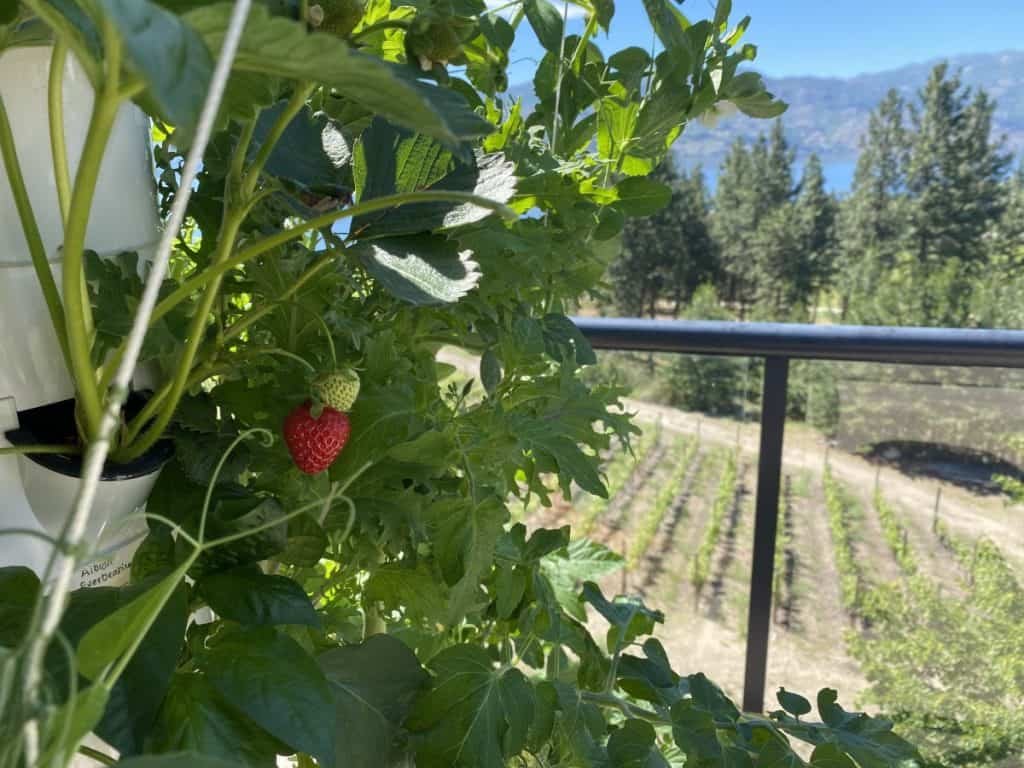
Watering Your Strawberries
Be sure to watch your strawberry plants for signs of over-watering or root rot, such as brown leaves, yellow spots, or looking wilted despite being consistently wet.
If you do see signs of over-watering, consider choosing a more absorbent growing medium, you can also adjust your watering schedule to water your plants less frequently. Start with minor adjustments until you reach a happy zone.
If this doesn’t solve your problems, it may be an issue of too much or too few nutrients getting to the roots of your plants. Make sure you are adding the appropriate amount of liquid nutrients for the water in your system (check the bottle, which should have guidelines).
Also, double-check that the growing medium in your pots is still clean and has not washed away.
Advantages to Growing Hydroponic Strawberries
There are quite a few reasons why you might consider growing hydroponic strawberries as opposed to a traditional soil-based method.
More Sustainable Farming
The first benefit to hydroponic gardening is that it is much more water-efficient, requiring only a fraction of the water and attention that a traditional soil garden needs.
While there is always water flowing through the system, it actually uses less water than a conventional garden because the same portion of water is recycled again and again in this system before being absorbed by the plants. Your hydroponic garden will require an occasional top up as the water level in the reservoir drops.
Fewer Pest Problems
Many of the pests which frequent gardens live in the soil; a hydroponic garden also means fewer pests bothering and damaging your strawberries.
Larger Yields From Hydroponics
If that wasn’t enough, hydroponically grown strawberries typically have much higher yields than strawberries grown in soil because of the lack of pests and the clean growing environment.
Faster Growing Cycle
Plants grown in this way not only yield more strawberries, but they grow and ripen more quickly as well because so many nutrients are frequently concentrated and circulating the plant’s roots.
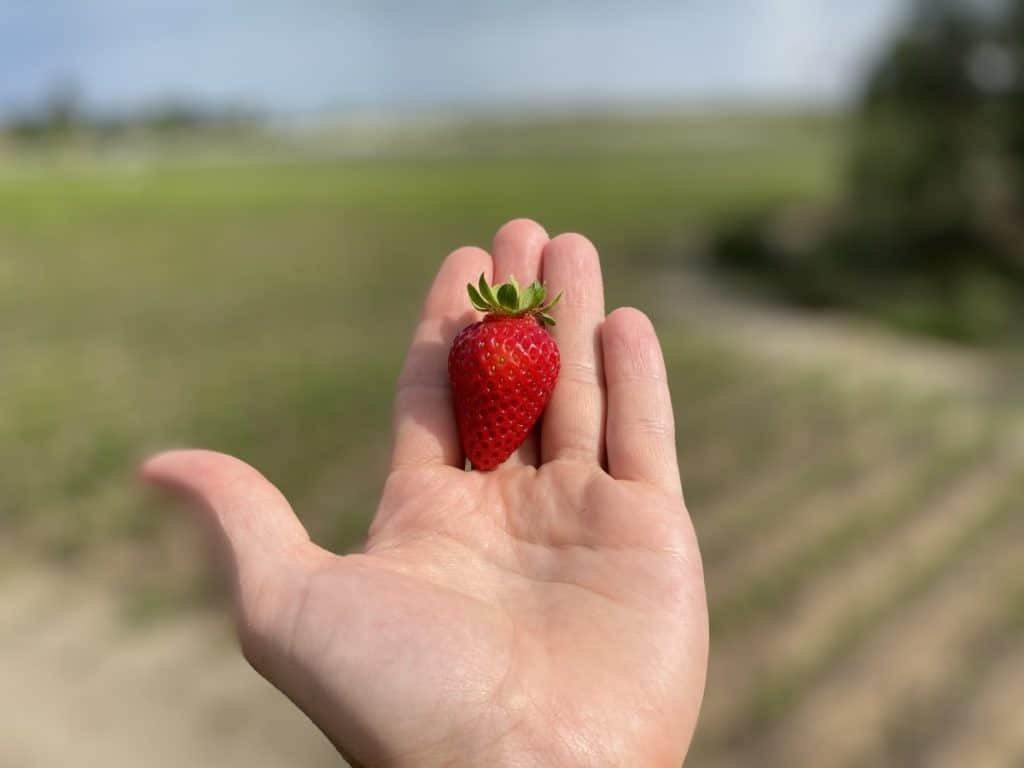
Small Scale Growing at Home
One last advantage to growing hydroponic strawberries is that they can take up a lot less space than a horizontal garden. They can be organized vertically in a hydroponic tower for a more efficient use of your space.
If you have limited greenhouse or garden space, this can be a great way to increase your yield without taking up additional space!
Hydroponic Strawberry Towers
If you want to maximize space in your greenhouse or gardening space, a vertical, hydroponic strawberry tower can be a great way to grow an increased number of strawberries in a smaller area.
Just like a traditional hydroponic system, a vertical hydroponic planter will have a water line running through it, with which you can provide nutrients directly to the roots of your plants.
Instead of running horizontally, this line will run from the top to the bottom of your planter, with plants growing in small pots out of the sides. Once it reaches the bottom, the water and nutrients will be pumped back to the top again, and so on.
There are several options if you want to go this route. Many companies have produced vertical hydroponic growing systems in a wide variety of sizes. While these can be pricey, they come ready to plant, and with the water system completely functional, often with feed lines prepared to plug right into your water source.
These vary in price, style, and size, so be sure to take note of your own space and growing needs as you research the right system to buy.

If you want to opt for a less expensive route, you can make your own homemade hydroponic tower. Many different tutorials offer different methods for doing this, many of which feature inexpensive and readily available materials.
Disadvantages of Growing Hydroponic Strawberries
While there are numerous fantastic advantages to growing strawberries in a hydroponic system, there are a few downsides as well:
Insects
This isn’t a disadvantage specific to hydroponics, as it is a problem in a traditional garden as well, but your strawberry plants in a hydroponic system will still be susceptible to certain airborne and foliage pests, even though they will not be exposed to any soil-based pests.
These include spiders and other insects; and, within the controlled environment of a greenhouse or indoor growing space and without natural predators, if they take over your plants, they can be a little tricky to get rid of.
Mildew
Indoor hydroponic plants are also particularly susceptible to airborne, powdery mildew, even more than outdoor plants. This mildew can be combatted by regulating the moisture and humidity levels of your greenhouse or interior space. A simple device like a dehumidifier can help with this if you find your room incredibly moist or humid.
Require Regular Monitoring
Another disadvantage to hydroponics is that there is no “self-regulation” in the way that an outdoor garden self-regulates in many ways. Outdoors, the soil and air have ways of regulating themselves to be a hospitable environment for and nourish your plants.
In a hydroponic system, you are directly in control of all these factors: moisture, nutrients, frequency of watering, light, etc. While this level of control can give you particularly great results—quicker growth, larger yields, etc., it also requires a lot of attention and balancing to keep plants alive and healthy.
Higher Upfront Cost
One other disadvantage of hydroponics, as opposed to soil gardening, can be the initial costs of implementing the system. Equipment, nutrients, and growth materials can be a significant investment, especially if you are purchasing a hydroponic system rather than building your own.
Of course, the eventual yields of your plants, as well as the space saved, can easily offset these costs over time. But it is a good idea to make sure you’re interested in maintaining your hydroponic plants for the long term before you invest in expensive equipment and materials.
Final Thoughts
There are many advantages to growing strawberries hydroponically, as opposed to in a soil garden, making hydroponic gardens a popular way of growing strawberries.
Most people find the costs worth the space saved, the added degree of control over their plants, and the rapid growth and large yields that a hydroponic system provides is worth the effort.
If you have the time and willingness to manage a hydroponic system and get the balance just right, it may very well be the best option for you and your strawberry plants.


